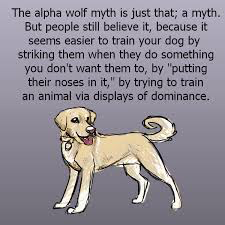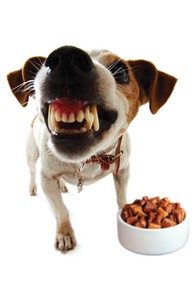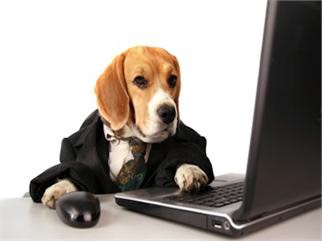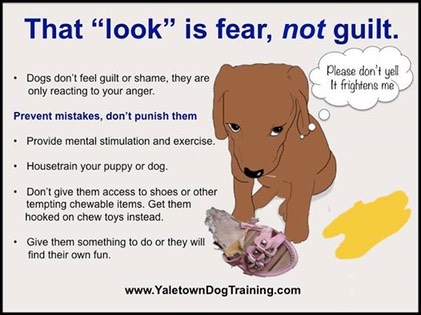
“Dogs are pack animals. They function within the social hierarchy of the human family constantly trying to climb the social ladder. They need an alpha”
“Your puppy is nipping because he is asserting his dominance over you/your girl friend/your child”
“Your dog is growling at you because she is showing you who the alpha is”
“Randomly put your hands in your dogs bowl as he eats to show him who is alpha and prevent him from getting food aggressive”
I hear statements like these every day from people trying to explain a dog’s behaviour. They usually come in response to help requests from other owners experiencing issues with their dogs. They are frequently followed with recommendations for those owners to respond using techniques that are questionable, have the potential to backfire on the owner and to cause greater damage or other larger issues. If this is pointed out to the well intentioned respondent, it is usually followed by “Well it worked for me and my dog”.
Just because something “worked” for you and your dog, does not mean it was right. It does not mean that it should be done. Years ago, it was common practice to teach a kid to swim by pushing them into the water over their heads and making them swim. While this practice “may” work, it has a greater likelihood of backfiring, making a kid completely fearful of the water and their parent. Why should it be any different for our dogs?
Let’s examine the statements…

1. Dogs are pack animals…
This approach to dog psychology came to prominence in the 50’s and 60’s and had many proponents. At the time, it was backed by a study of wolves done by Dr. L. David Mech. Mech's study examined a pack of captive wolves and made a number of generalizations to our own domestic dogs including viewing the wolf pack as a group in which “might makes right”.
The study was based on available research at the time. It was later refuted by scholars including Mech himself. Modern day science knows that wolf packs are actually most often family groups. These groups are formed and have similar rules and dynamics to the modern human family.
Despite all of the inaccuracies and invalid assumptions drawn from the work around this time, the feeling that we have to view our domestic dogs as social hierarchy climbers who are consistently looking to increase their status in the human pack remains. It also means that we as humans, tend to react to our dog’s behaviours in ways that are both unjustified and unfair.
2. Puppy nipping because of dominance…
Oh boy, this one kills me. The idea here is that the puppy is trying to put it’s human into his or her place by mouthing. Taking a behaviour such as this one, especially when it comes to talking about your puppy and attributing it to dominance, is the equivalent of saying that your two year old is trying to rule the roost in your house. Let’s get it straight….your puppy is no more trying to rule the roost than your two year old is. A puppy nipping usually has NOTHING to do with dominance but more to do with a rude learned behaviour. Your puppy does not know it is rude. You have to teach him.
3. Your growling dog is showing dominance…
This one is so dangerous. It invokes responses to handle the situation by putting the dog in his place, grabbing the dog, rolling the dog on his back and other asinine methods of interaction. The idea is that if you show dominance to your dog, your dog will submit and learn he is not the top dog. Most times, this leads to disaster. The dog becomes more and more afraid of the owner and may finally snap in an effort to make themselves understood. Violence is never a solution to solve this type of situation.

4. Randomly sticking your hands in a dog’s bowl to prevent resource guarding
This one is similar to number three. The idea is that if you condition your dog to allow you to have your hand in the bowl or to take the bowl at random times, it is showing your dog you are the alpha and that he can and should allow it to happen.
The result is usually a dog who looks at his owner as a bully especially at meal time. He has no recourse but to allow something like this to happen. If this “works” it is because you have just defeated your dog.
The thing that upsets me about most of these issues and the responses to the same is that it makes explaining a dog’s behaviour too complex. It is in the realm of pseudo science. It leaves way too much room for error and elicits responses which can and often do backfire on the owner. While they may “solve” the presenting issue, often the responses cause other more serious issues to develop.

So what is an owner to do?
Let’s start viewing our dogs similar to the way we view our human families. If dogs have packs that develop similar to our families AND have similar rules for interaction…let’s use that to examine how we deal with behaviour issues with our dogs.
1. Abandon the whole idea of the alpha. Forget the rhetoic and all it entails. It is outdated and based on inaccurate information. While children need somebody to parent, guide, protect them andu set appropriate rules and boundaries, they do not need somebody to lord over them. As a parent you know you need to communicate effectively with your child. As a parent, you need to set your child up for success, helping guide and teach her with her interactions with society at large. Guess what? The same is true with owning a dog. As an owner, develop proper and effective communication strategies with your dog. Use incidents as learning experiences. Foster an environment of consistency and trust where your dog develops. It will result in a much happier dog and in turn, a much happier owner.
2. Forget about the alpha roll, grabbing the dog, pushing down on a dog’s tongue to stop biting, tapping on the nose, biting the dog back and randomly sticking your hands on your dogs bowl. These are outdated and often times, dangerous responses to behavioural issues. Instead, start looking at a dog’s behaviour in the following very SIMPLE way:
Dogs commit an action in order to get a desired reaction. If their action gives them the desired reaction, they will continue to do it. When their action does not give them the desired reaction, they move onto a different action in order to achieve the same results. Control the results, you control the action.
What this means is that if a dog is nipping, it is probably because somewhere along the line he has learned that nipping means play. If you immediately and consistently end play when your puppy nips, immediately and consistently continue the play when your puppy does not nip, your puppy learns what actions allow the play to continue and what actions mean the play ends. The same technique can be used to describe many facets of a dog’s behaviour and results in a behaviour continuing or being eliminated.
3. Sticking your hands in a dogs bowl will not prevent future resource guarding nor will kicking a dog’s butt for responding negatively to you trying to do so. View this as if you were the one eating. If you were eating and somebody randomly stopped you by shoving their hand in your food or taking your food away, would it make you feel any easier? Probably not. You would be much more likely to become frustrated. It would probably make you view that person as a bully and make you want to eat all the quicker before the food gets taken away. In other words, it would actually encourage resource guarding.
If resource guarding is an issue that concerns you, engage in activities early in a dogs life to counter condition and desensitize your dog to somebody approaching the bowl. When your dog is eating, call to him…when he pauses eating to look at you, give him a treat as a reward that is of higher caliber than the food. If you consistently reward the dog for coming away from his bowl with a higher reward than the food he is eating, he will have no problem at all with giving up his food to you.
4. Realize that when a dog growls at you, he is attempting to communicate something. He is giving you a warning he is uncomfortable with what is occurring. Realize this attempt at communication for what it is, take pause and learn to communicate back.
If a dog is growling because he is uncomfortable or fearful, realize you need to step up your game. Counter condition and desensitize your dog to whatever the stimulus is. A good quality trainer is invaluable in these instances. This professional will be able to examine the situation, explain what is happening and set you up with a plan to deal with it. One word of caution, I say a “good quality trainer”…if the trainer explains the behaviour using any statements similar to those at the start of this post…run. That is not a good quality trainer!

At the end of the day, viewing a dog’s behaviour has little to do with social hierarchies, dominance and being a alpha. It has more to do with developing proper communication with your dog. Once you forget the psycho babble that is much too prevalent in society and start simplifying your view of your dog's motivation , a whole world opens up. It will allows a secure trust and bond to form between you and your dog. In the end it makes for a much happier owner and in turn, a much more happy and confident dog